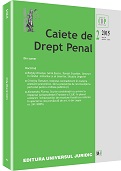Omoruri în rândul minorilor şi al tinerilor. Situaţia Ungariei
Homicides in Hungary: juveniles and young adults
Author(s): Bolyky Orsolya, Eszter Sárik, Erzsébet TamásiSubject(s): Law, Constitution, Jurisprudence
Published by: Universul Juridic
Keywords: homicide; juvenile; young adults; Hungarian system; background; relevant factors; criminological study; interior factors; crime motivation.
Summary/Abstract: Considering the research-focus of criminology, the first idea generally coming to mind is probably the question of homicide. However, this issue is hardly ever discussed practically. In the following article we would like to interpret a file-based research conducted in Hungary at the National Institute of Criminology in 2011 by Orsolya Bolyky, Eszter Sárik and Erzsébet Tamási. The research covered 115 criminal files, containing the data of 165 juvenile and young adult offenders between the age of 14 and 24, and 124 victims. Our goal was to gain extensive knowledge about the domestic, socio-economical, psychological and criminal background of the perpetrators by using 5 questionnaires of diverse scientific focus. Hereby we will attempt to summarize the general outcomes of the research: examining the country data, the basic data – such as gender and age, and the relevant socio-economic factors. We would like to interpret the relevancy of domestic background, and how the lack of the entire family influences juveniles’ behaviour even in the question of homicide. We have also discussed the significant role of school and education, because there is an obvious pattern in school attainment to be drawn from the outcomes of our research. Usually children at risk start out from ordinary school system then get to special educational forms and they end-up in drop-outs from the whole educational system. As part of the research, we tried to explore the interior factors: such as the motivation of crime, the psychological and biological background, the issue of committers’ alcoholand drug abuse as well as the addiction problems within the family. We have categorized the motivations of crimes into 7 categories - homicide committed upon: 1.) financial gain, 2.) impulse (anger, revenge, jealousy, and quarrel), 3.) sadism or humiliation, 4.) sexual motives, 5.) “legitimate” reasons (fear, solidarity, hidden pregnancy, self-defence), 6.) dissemble of another crime, 7.) or without any apparent motivation. The main motivation of this age group was the financial gain but even these acts impulse played significant role. The second most common motive was pure impulse which often went with excessive alcohol consumption. As far as substance-use, our findings were the followings: the majority of the offenders were regularly drunk and were frequent drug-users; many of their family members had alcohol problems mostly it was the father suffering from that. Although the presence of alcohol and drug is well-documented in most of the cases, the forensic psychiatrist stated that only half of the perpetrators were influenced by alcohol at the moment of the commitment of the crime and only in 20 cases out of the whole sample were the committers influenced of some drugs.
Journal: Caiete de drept penal
- Issue Year: XI/2015
- Issue No: 02
- Page Range: 11-39
- Page Count: 29
- Content File-PDF

